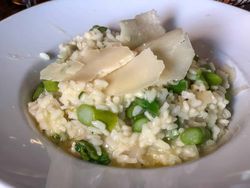As Spring arrives, Britain’s asparagus spears begin to surface, ready to be greeted with almost religious fervour on Instagram. While the season doesn’t officially begin until late April, typically lasting until June, British asparagus seems to become available earlier each year, with some producers having already harvested. In addition to containing essential vitamins and health benefits, believed to help detoxify the body and increase libido, Asparagus is also delicious in a variety of recipes. Simply serve with hollandaise sauce and/or poached eggs, or raw, shaved and dressed with some olive oil and parmesan. I’m also particularly fond of asparagus risotto, with a good squeeze of lemon juice.
A true celebration of rice, risotto requires a fair amount of energy to cook, but the result is always far greater than the sum of its basic parts. Although rice has been grown in southern Italy since the 14th century, risotto is most commonly considered a northern dish, specifically associated with Milan. It’s believed that the first recipe identifiable as a risotto dates back to the early 1800s, including rice sautéed in butter, with sausages, bone marrow, onions, and hot stock, coloured with saffron. Today, however, there are hundreds of risotto recipe variations, with the base ingredients acting as a canvas. Yet regardless of supplementary ingredients, the formulaic production is essential for any risotto, demanding to be stirred, using a short grain rice (Arborio or Carnaroli are the easiest to get hold of in the UK) whose starch contributes to the creaminess of the dish.
This asparagus risotto recipe is fairly simple, sweating shallots in butter and combining them with the rice before adding a splash of white wine, followed by chicken stock (or vegetable stock to make the dish vegetarian) one ladle at a time. Once the rice is al dente, after around 20-25 minutes of cooking, remove from the heat and gently fold in a good amount of butter, chopped parsley, lemon juice, and a generous amount of parmesan (or vegetarian alternative).
The basis of this asparagus risotto recipe can also be used for a variety of risottos. Artichoke is great as a straight swap for asparagus, while peas are also a delicious addition (with asparagus) once in season. Alternatively switch the white wine for vermouth, or red wine and cook with sausage meat and rosemary. Also, it’s worth cooking extra and making arancini with the leftovers. The possibilities are virtually endless.

Asparagus Risotto
Ingredients
- 1 bunch asparagus approx. 250g
- 2.5 l chicken stock alternatively use vegetable stock to make the dish vegetarian
- 2 Echalion shallots finely chopped
- 400 g Arborio or Carnaroli rice
- 250 ml dry white wine
- 50 g butter
- 2 tbsp olive oil/rapeseed oil
- 1 lemon juice only
- 50 g parmesan (or vegetarian alternative) grated
- 50 g parmesan (or vegetarian alternative) shaved with a peeler or mandolin
- 50 g flat leaf parsley finely chopped
Instructions
- First, heat the stock in a saucepan and keep warm over a low heat.
- In a separate large frying pan or wok, heat half of the butter and the oil and add the shallots to the pan. Season with salt and cook the shallots over a low heat until translucent.
- Meanwhile, wash the asparagus, trim the woody ends and discard, then slice into approx. 3cm pieces. Set aside.
- When the shallots become translucent, add the rice to the pan, increase the heat to medium-high and stir quickly until the onions, butter and rice are combined. This will take between a minute and 90 seconds. Pour the wine into the pan, increase the heat to high and stir until the wine is absorbed.
- Next, begin to add the stock to the pan containing the rice, one ladleful at a time, and stir almost continuously until most of the liquid is absorbed. After repeating this process for around 15 minutes, add the asparagus to the pan and continue to gradually stir in the broth for a further 10 minutes, or until the rice is al dente. (Don’t worry if you don’t end up using all of the stock). Taste after five minutes.
- As soon as the rice is cooked al dente and a the risotto has good consistency, remove the pan from the heat. Add the rest of the butter, the lemon juice, parsley, the grated parmesan, and a pinch of salt (if needed). Gently fold until all is incorporated, then plate evenly between four bowls.
- To finish, scatter the parmesan shavings over each dish, and season with a crack of black pepper.
RELATED: How To Make: Butter

